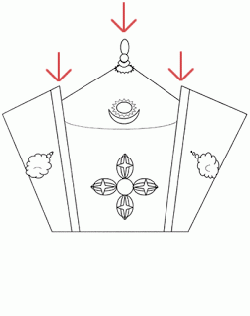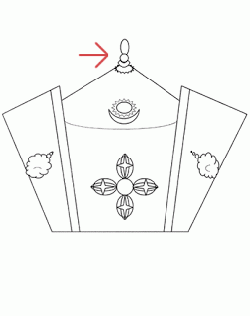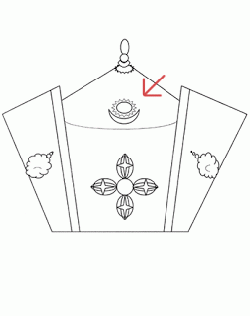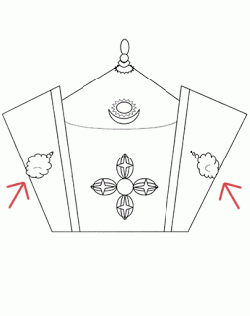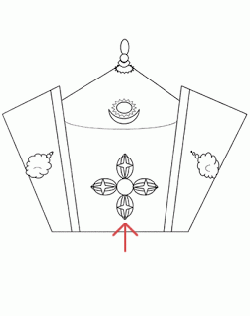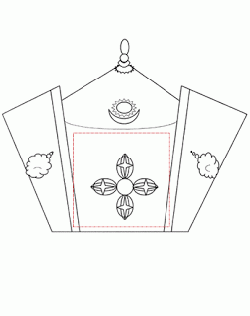Difference between revisions of "The Black Crown of the Karmapas"
m (Text replacement - "]]]" to "]])") |
|||
| (2 intermediate revisions by one other user not shown) | |||
| Line 1: | Line 1: | ||
[[File:Bla_ered_f03.gif|thumb|250px|]][[File:Black_d_f04.gif|thumb|250px|]] [[File:Bl_red_f05.gif|thumb|250px|]][[File:Black_f06.gif|thumb|250px|]] [[File:Bla_d_f07.gif|thumb|250px|]][[File:Blac_ed_f08.gif|thumb|250px|]] | [[File:Bla_ered_f03.gif|thumb|250px|]][[File:Black_d_f04.gif|thumb|250px|]] [[File:Bl_red_f05.gif|thumb|250px|]][[File:Black_f06.gif|thumb|250px|]] [[File:Bla_d_f07.gif|thumb|250px|]][[File:Blac_ed_f08.gif|thumb|250px|]] | ||
| − | |||
| − | |||
| − | Legend tells that in a previous [[eon]], in a former [[life]] as an accomplished [[yogi]], the [[Karmapa]] [[attained]] the eighth level or [[bhumi]] of the [[bodhisattvas]]. At this [[time]], 100,000 [[dakinis]] ({{Wiki|female}} [[buddhas]]) [[manifested]] their [[hair]] as a {{Wiki|crown}}, and [[offered]] it to the [[Karmapa]] as a [[symbol]] of his [[accomplishment]]. [[Dusum Khyenpa]], the [[1st Karmapa]], was regarded as an [[emanation]] of that [[yogi]] and his [[appearance]] was predicted by the [[historical Buddha]] [[Shakyamuni]] in the [[Samadhiraja Sutra]]: | + | |
| + | |||
| + | |||
| + | |||
| + | The Legend | ||
| + | |||
| + | Legend tells that in a previous [[eon]], in a former [[life]] as an accomplished [[yogi]], the [[Karmapa]] [[attained]] the eighth level or [[bhumi]] of the [[bodhisattvas]]. | ||
| + | |||
| + | At this [[time]], 100,000 [[dakinis]] ({{Wiki|female}} [[buddhas]]) [[manifested]] their [[hair]] as a {{Wiki|crown}}, and [[offered]] it to the [[Karmapa]] as a [[symbol]] of his [[accomplishment]]. [[Dusum Khyenpa]], the [[1st Karmapa]], was regarded as an [[emanation]] of that [[yogi]] and his [[appearance]] was predicted by the [[historical Buddha]] [[Shakyamuni]] in the [[Samadhiraja Sutra]]: | ||
"A [[bodhisattva]] with the [[lion’s roar]] will appear. He will use the power he achieved in deep [[meditation]] to [[benefit]] countless [[beings]]. By [[seeing]], hearing, {{Wiki|touching}} or [[thinking]] of him, they will be led to [[happiness]]." | "A [[bodhisattva]] with the [[lion’s roar]] will appear. He will use the power he achieved in deep [[meditation]] to [[benefit]] countless [[beings]]. By [[seeing]], hearing, {{Wiki|touching}} or [[thinking]] of him, they will be led to [[happiness]]." | ||
| − | |||
| − | In preparation for the | + | |
| + | ===The [[Black Crown Ceremony]]=== | ||
| + | |||
| + | |||
| + | |||
| + | In preparation for the [[Black Crown ceremony]] the [[Karmapa]] [[meditates]] to become [[inseparable]] with [[Chenrezig]], the [[Buddha of Compassion]]. | ||
| + | |||
| + | A [[mandala offering]] is made, followed by the [[seven branch prayer]]. | ||
| + | |||
| + | This is to [[accumulate]] good [[impressions]] for the {{Wiki|ceremony}} that ensues. The [[Karmapa]] then places the {{Wiki|crown}} on his head while reciting the [[mantra]] '[[Om Mani Peme Hung]]', | ||
| + | |||
| + | transmitting [[blessings]] to each participant in the {{Wiki|ceremony}} to the extent that they are capable of receiving them. It is said that by merely [[seeing]] of the [[Black Crown]] during the {{Wiki|ceremony}}, one will become the [[first bhumi]] [[bodhisattva]] within three [[lifespans]]. | ||
| + | |||
| + | This is one of the key [[reasons]] why the [[Black Crown]] is so important to [[Kagyu lineage]]. | ||
Brieffly in the origin of the [[physical]] ornament | Brieffly in the origin of the [[physical]] ornament | ||
| − | |||
| − | The [[Karmapa]] explained to the [[Emperor]] that he could see the '[[Vajra]] {{Wiki|Crown}}', the power-field of wisdom-energy that always stays above the [[Karmapa's]] head. The [[emperor]] [[offered]] to have a [[physical]] replica made so that others could receive its [[blessing]]. A {{Wiki|crown}} encrusted with [[precious]] stones and topped by a huge {{Wiki|ruby}} was commissioned, and using this, the [[5th Karmapa]] started the [[tradition]] of the [[Black Crown]] | + | The [[Karmapas]] were [[traditionally]] the [[teachers]] of the successive {{Wiki|Ming Dynasty}} [[Emperors]] of [[China]]. |
| + | |||
| + | When the [[5th Karmapa]], [[Dezhin Shegpa]], met the {{Wiki|Chinese}} [[Emperor]] [[Yung Lo]], the [[Emperor]], through his [[devotion]] and [[spiritual]] [[realization]], was able to {{Wiki|perceive}} [[Karmapa]] in the [[Sambhogakaya]] [[form]] of [[Vajradhara]] (Tib. [[Dorje Chang]]), wearing a [[black crown]] on his head. | ||
| + | |||
| + | |||
| + | The [[Karmapa]] explained to the [[Emperor]] that he could see the '[[Vajra]] {{Wiki|Crown}}', the power-field of [[wisdom-energy]] that always stays above the [[Karmapa's]] head. | ||
| + | |||
| + | The [[emperor]] [[offered]] to have a [[physical]] replica made so that others could receive its [[blessing]]. | ||
| + | |||
| + | A {{Wiki|crown}} encrusted with [[precious]] stones and topped by a huge {{Wiki|ruby}} was commissioned, and using this, the [[5th Karmapa]] started the [[tradition]] of the [[Black Crown Ceremony]] which was performed by successive [[Karmapa incarnations]] up to the [[time]] of the [[16th Karmapa]], [[Rangjung Rigpe Dorje]]. | ||
| + | |||
| + | |||
| + | |||
| + | ===The [[Origin of the Vajra Crown]] by [[Lama]] [[Karma Wangchuk]]=== | ||
| + | |||
| + | |||
| + | |||
| + | Let me briefly recount the story of the [[Black Crown]]. | ||
| + | |||
| + | When the [[Emperor]] [[Yung Lo]] met the [[5th Karmapa]] [[Dezhin Shegpa]] numerous [[miracles]] and [[signs]] appeared in the sky for the 18 days that [[Karmapa]] gave public teachings. | ||
| + | |||
| + | Famous {{Wiki|Chinese}} painters and calligraphers of the period copied these [[signs]] daily and wrote descriptions of them in the four main [[languages]] of the {{Wiki|Chinese}} [[Empire]] {{Wiki|Mongolian}}, [[Wikipedia:Mandarin Chinese|Mandarin]], [[Tibetan]] and [[Turkic]]. | ||
| + | |||
| + | They [[form]] the basis of our [[understanding]] of how the [[Emperor]] came to give the [[Black Crown]] to the [[Karmapa]]. | ||
| + | |||
| + | After several days of teachings, the [[Emperor]] said to [[Karmapa]], Whenever you perform a {{Wiki|ceremony}} of [[blessing]], you always appear to me in a special way. | ||
| + | |||
| + | Your [[body]] is in the [[form]] of [[Vajradhara]] and you are wearing a kind of black turban or {{Wiki|crown}} on your head. | ||
| + | |||
| + | [[Karmapa]] responded that it could be that when the [[body]] of a great [[bodhisattva]] is [[teaching]] in [[human]], or [[nirmanakaya form]], this [[body]] can also be simultaneously [[manifested]] in [[sambhogakaya]], or [[ethereal form]]. | ||
| + | |||
| + | To further answer the [[emperor]]' s question, [[Karmapa]] explained that many [[eons]] in the {{Wiki|past}}, in a previous [[life]] as a cave-meditator, [[Karmapa]] [[attained]] the eighth [[bodhisattva bhumi]]. | ||
| + | |||
| + | Then, a hundred thousand [[wisdom dakinis]] cut their black [[hair]] and [[offered]] it to [[Karmapa]] as an [[offering]]. | ||
| + | |||
| + | They [[manifested]] their [[hair]] as a {{Wiki|crown}} that they placed on his head and [[enthroned]] [[Karmapa]] as a [[Buddha]] for their [[sambhogakaya]] land. | ||
| + | |||
| + | The [[5th Karmapa]] said that the [[1st Karmapa]], [[Dusum Khenpa]] was an [[emanation of sambhogakaya Buddha]] for our [[world]]. | ||
| + | |||
| + | The [[emperor]] marveled at this story, and in his [[devotion]] [[offered]] to have a replica of this {{Wiki|crown}} made for [[Karmapa]]: | ||
| + | |||
| + | If I make a similar {{Wiki|crown}} and offer it to you, can you give the [[blessing]] of the [[sambhogakaya Buddha]] to [[sentient beings]]? | ||
| + | |||
| + | [[Karmapa]] responded, Yes, the [[bodhisattva]] s [[blessing]] depends on his [[having attained]] the wish [[paramita]]--that whatever he wishes for [[sentient beings]] will come true--so this is possible. | ||
| + | |||
| + | The [[emperor]] was very [[pleased]]. He left [[Karmapa]], and ordered the most [[skilled]] craftsmen to make a {{Wiki|crown}} studded with [[precious]] stones and crowned by a rare {{Wiki|ruby}} the size of a [[human]] fingertip. | ||
| + | |||
| + | The [[5th Karmapa]] accepted this [[gift]] and began the [[tradition]] of the [[black crown ceremony]]. | ||
| + | |||
| + | Since then, when any [[Karmapa]] performs this [[Black crown ceremony]], he [[meditates]] in the [[form]] of a [[sambhogakaya Buddha]] and thus gives a unique [[empowerment]] of [[samadhi]] and [[wisdom]] to those in [[attendance]]. | ||
| + | |||
| + | [[Karmapas]] from the 5th through the 16th wore this {{Wiki|crown}} and gave this [[blessing]] through the {{Wiki|ceremony}}. | ||
| − | |||
| − | |||
| − | + | ===The [[Qualities of the Vajra Crown]]=== | |
| − | |||
| − | |||
| − | [[ | + | The [[Vajra Crown]], or [[black crown]], of the [[Karmapas]] is replete with profound and [[symbolic]] meaning. The shape and ornamentation of the {{Wiki|crown}} display the [[enlightened qualities]] of the [[Karmapas]]. |
| − | |||
| − | |||
| − | |||
The [[Symbolism]]: | The [[Symbolism]]: | ||
| − | |||
| − | The [[ | + | The [[Unchanging Dharmata]]: The {{Wiki|Color}} of the [[Vajra crown]] is [[dark blue]], representing the [[unchanging nature of reality]], [[dharmata]], of all [[phenomena]]. |
| + | |||
| + | The {{LTSW|realization of enlightenment}}[[realization of enlightenment]] is also [[unchanging]], like [[space]], and that basic [[space]] is represented here by the [[dark blue]] {{Wiki|color}}. | ||
| + | |||
| + | The [[Three Kayas]]: the [[Three Points of the Vajra Crown]], one in the middle, and two at the sides, | ||
| + | |||
| + | |||
| + | represent the [[spontaneous presence]] of the [[three kaya buddhahood]]: | ||
| + | |||
| + | |||
| + | |||
| + | 1. [[dharmakaya]], | ||
| + | 2. [[sambhogakaya]] and | ||
| + | 3. [[nirmanakaya]]. | ||
| + | |||
| + | |||
| + | |||
| + | The [[Lord]] of the [[Mandala]]: the Top Ornament of the [[Vajra Crown]] represents the pinnacle of [[wisdom]] and the [[Lord]] of the [[Mandala]] in the [[Vajrayana teachings]]. | ||
| + | |||
| + | It also represents the unobstructed play of the [[buddha wisdom]]. | ||
| + | |||
| + | The [[Two Wisdoms of the Buddha]]: | ||
| + | |||
| + | <poem> | ||
| + | the {{Wiki|Sun}} and | ||
| + | the [[Moon]], | ||
| + | </poem> | ||
| + | |||
| + | made from [[precious]] [[jewels]], | ||
| + | |||
| + | |||
| + | ornament the [[Vajra Crown's]] center-top section representing the [[two wisdoms of the buddha]]: | ||
| + | |||
| + | 1) the [[wisdom of seeing things as they are]] and | ||
| + | 2) the [[wisdom of seeing the extent of things]], | ||
| + | |||
| + | which is obtained through the [[achievement]] of the [[dharmakaya]] [[buddhahood]] | ||
| + | |||
| + | |||
| + | |||
| + | The [[Buddha]] [[Activities]]: the Cloud Ornaments decorate the left and right side of the {{Wiki|crown}} with beautiful clouds, representing the [[immeasurable]] and unbiased [[rain]] of [[wisdom]] and [[compassion]], | ||
| + | |||
| + | which is the [[activities]] of the [[buddhas]] and [[tenth level]] [[bodhisattvas]], in benefitting all [[sentient beings]]. | ||
| + | |||
| + | The [[tenth bhumi]] of the [[bodhisattva path]] is also called the "[[cloud of dharma]]." | ||
| + | |||
| + | |||
| + | |||
| + | The [[Four Enlightened Activities]]: | ||
| − | + | the Crossed [[Vajra]] or [[Dorje Gyatram]] ornately beautifies the front of the {{Wiki|crown}}, containing five different colors of [[precious]] [[gems]], representing the [[five colors]] of the [[buddha families]]. | |
| − | |||
| + | The prongs of the [[vajra]] represent the [[four enlightened activities]] of | ||
| − | + | <poem> | |
| + | pacifying, | ||
| + | enriching, | ||
| + | magnetizing and | ||
| + | destroying. | ||
| + | </poem> | ||
| − | The | + | The [[Four Immeasurables]]: the Base, made up of the four-cornered quadrilateral area forming the square or v-shaped base for the [[crossed-vajra]] ornament, represents the [[four immeasurables]]: |
| − | |||
| + | <poem> | ||
[[loving-kindness]]; | [[loving-kindness]]; | ||
[[compassion]]; | [[compassion]]; | ||
[[joy]]; | [[joy]]; | ||
[[equanimity]] towards all [[sentient beings]]. | [[equanimity]] towards all [[sentient beings]]. | ||
| + | </poem> | ||
| + | |||
This is how [[His Holiness]] leads [[beings]] through the [[path]] to the [[fruition]] of complete [[awakening]]. | This is how [[His Holiness]] leads [[beings]] through the [[path]] to the [[fruition]] of complete [[awakening]]. | ||
| − | + | By [[Lama]] [[Karma Wangchuk]] | |
| + | |||
| + | Let me briefly recount the story of the [[Black Crown]]. | ||
| + | |||
| + | When the [[Emperor]] [[Yung Lo]] met the [[5th Karmapa]] [[Dezhin Shegpa]] numerous [[miracles]] and [[signs]] appeared in the sky for the 18 days that [[Karmapa]] gave public teachings. | ||
| + | |||
| + | Famous {{Wiki|Chinese}} painters and calligraphers of the period copied these [[signs]] daily and wrote descriptions of them in the four main [[languages]] of the {{Wiki|Chinese}} [[Empire]] {{Wiki|Mongolian}}, [[Wikipedia:Mandarin Chinese|Mandarin]], [[Tibetan]] and [[Turkic]]. | ||
| + | |||
| + | They [[form]] the basis of our [[understanding]] of how the [[Emperor]] came to give the [[Black Crown]] to the [[Karmapa]]. | ||
| + | |||
| + | After several days of teachings, the [[Emperor]] said to [[Karmapa]], Whenever you perform a [[ceremony of blessing]], you always appear to me in a special way. | ||
| + | |||
| + | Your [[body]] is in the [[form]] of [[Vajradhara]] and you are wearing a kind of black turban or {{Wiki|crown}} on your head. | ||
| + | |||
| + | [[Karmapa]] responded that it could be that when the [[body]] of a great [[bodhisattva]] is [[teaching]] in [[human]], or [[nirmanakaya]] [[form]], this [[body]] can also be simultaneously [[manifested]] in [[sambhogakaya]], or [[ethereal form]]. | ||
| + | |||
| + | To further answer the [[emperor's]] question, [[Karmapa]] explained that many [[eons]] in the {{Wiki|past}}, in a previous [[life]] as a cave-meditator, [[Karmapa]] [[attained]] the ppeighth [[bodhisattva bhumi]])]. | ||
| + | |||
| + | Then, a hundred thousand [[wisdom dakinis]] cut their black [[hair]] and [[offered]] it to [[Karmapa]] as an [[offering]]. | ||
| + | |||
| + | They [[manifested]] their [[hair]] as a {{Wiki|crown}} that they placed on his head and [[enthroned]] [[Karmapa]] as a [[Buddha]] for their [[sambhogakaya]] land. | ||
| + | |||
| + | The [[5th Karmapa]] said that the [[1st Karmapa]], [[Dusum Khenpa]] was an [[emanation of sambhogakaya Buddha]] for our [[world]]. | ||
| + | |||
| + | The [[emperor]] marveled at this story, and in his [[devotion]] [[offered]] to have a replica of this {{Wiki|crown}} made for [[Karmapa]]: | ||
| + | |||
| + | If I make a similar {{Wiki|crown}} and offer it to you, can you give the [[blessing]] of the [[sambhogakaya Buddha]] to [[sentient beings]]? | ||
| + | |||
| + | [[Karmapa]] responded, Yes, the [[bodhisattvas]] [[blessing]] depends on his [[having attained]] the wish [[paramita]]--that whatever he wishes for [[sentient beings]] will come true--so this is possible. | ||
| + | |||
| + | The [[emperor]] was very [[pleased]]. He left [[Karmapa]], and ordered the most [[skilled]] craftsmen to make a {{Wiki|crown}} studded with [[precious]] stones and crowned by a rare {{Wiki|ruby}} the size of a [[human]] fingertip. | ||
| + | |||
| + | The [[5th Karmapa]] accepted this [[gift]] and began the [[tradition]] of the [[Black Crown Ceremony[[. | ||
| + | |||
| + | Since then, when any [[Karmapa]] performs this {{Wiki|ceremony}}, he [[meditates]] in the [[form]] of a [[sambhogakaya Buddha]] and thus gives a unique [[empowerment]] of [[samadhi]] and [[wisdom]] to those in [[attendance]]. [[Karmapas]] from the 5th through the 16th wore this {{Wiki|crown}} and gave this [[blessing]] through the {{Wiki|ceremony}}. | ||
| + | |||
| + | |||
| + | |||
| + | The [[Qualities of the Vajra Crown]] | ||
| + | |||
| + | |||
| + | |||
| + | The [[Vajra Crown]], or [[Black Crown]], of the [[Karmapas]] is replete with profound and [[symbolic]] meaning. | ||
| + | |||
| + | The shape and ornamentation of the {{Wiki|crown}} display the [[enlightened qualities of the Karmapas]]. Below a closer look at some of the most significant aspects of the [[Vajra Crown]]. | ||
| + | |||
| − | |||
| − | + | ===The [[Unchanging Dharmata]]=== | |
| − | |||
| − | |||
| − | + | The {{Wiki|Color}} of the [[Vajra Crown]] is [[dark blue]], Representing the [[unchanging nature of reality]], [[dharmata]], of all [[phenomena]]. | |
| − | The [[ | + | The [[realization of enlightenment]] is also [[unchanging]], like [[space]], and that basic [[space]] is represented here by the [[dark blue]] {{Wiki|color}}. |
| − | |||
| − | |||
| − | The [[ | + | ===The [[Three Kayas]]=== |
| − | |||
| − | |||
The Three Points of the [[Vajra]] {{Wiki|Crown}}, one in the middle, and two at the sides, represent the [[spontaneous presence]] of the [[three kaya]] [[buddhahood]]: 1. [[dharmakaya]] 2. [[sambhogakaya]] and 3. [[nirmanakaya]] | The Three Points of the [[Vajra]] {{Wiki|Crown}}, one in the middle, and two at the sides, represent the [[spontaneous presence]] of the [[three kaya]] [[buddhahood]]: 1. [[dharmakaya]] 2. [[sambhogakaya]] and 3. [[nirmanakaya]] | ||
| Line 89: | Line 242: | ||
The Top Ornament of the [[Vajra]] {{Wiki|Crown}} represents the pinnacle of [[wisdom]] and the [[Lord]] of the [[Mandala]] in the [[Vajrayana teachings]]. It also represents the unobstructed play of the [[buddha wisdom]]. | The Top Ornament of the [[Vajra]] {{Wiki|Crown}} represents the pinnacle of [[wisdom]] and the [[Lord]] of the [[Mandala]] in the [[Vajrayana teachings]]. It also represents the unobstructed play of the [[buddha wisdom]]. | ||
| − | |||
| − | |||
| − | The [[Buddha]] [[Activities]] | + | ===The [[Two Wisdoms of the Buddha]]=== |
| + | |||
| + | |||
| + | |||
| + | The {{Wiki|Sun}} and the [[Moon]], made from [[precious]] [[jewels]], | ||
| + | |||
| + | ornament the crown's center-top section representing the [[two wisdoms of the buddha]]: | ||
| + | |||
| + | 1) the [[wisdom]] of [[seeing]] things as they are and | ||
| + | 2) the [[wisdom]] of [[seeing]] the extent of things, | ||
| + | |||
| + | which is obtained through the [[achievement]] of the [[dharmakaya]] [[buddhahood]] | ||
| + | |||
| + | |||
| + | |||
| + | ===The [[Buddha Activities]]== | ||
| + | |||
| + | |||
| + | |||
| + | The Cloud Ornaments decorate the left and right side of the {{Wiki|crown}} with beautiful clouds representing the [[immeasurable]] and unbiased [[rain]] of [[wisdom]] and [[compassion]], which is the [[activities of the buddhas]] and [[tenth level bodhisattvas]], in benefitting all [[sentient beings]]. | ||
| + | |||
| + | The [[tenth bhumi]] of the [[bodhisattva path]] is also called the "[[cloud of dharma]]." | ||
| + | |||
| + | |||
| + | |||
| + | ===The [[Four Enlightened Activities]]== | ||
| + | |||
| + | |||
| + | |||
| + | The [[Crossed Vajra]] or [[Dorje Gyatram]] ornately beautifies the front of the {{Wiki|crown}}, containing five different colors of [[precious]] [[gems]] representing the [[five colors]] of the [[buddha families]]. | ||
| + | |||
| + | |||
| + | The prongs of the [[vajra]] represent the [[four enlightened activities]] of | ||
| + | |||
| + | <poem> | ||
| + | pacifying, | ||
| + | enriching, | ||
| + | magnetizing and | ||
| + | destroying. | ||
| + | </poem> | ||
| + | |||
| + | |||
| + | ===The [[Four Immeasurables]]=== | ||
| + | |||
| − | |||
| − | The | + | The Base, made up of the four-cornered quadrilateral area forming the square or v-shaped base for the [[crossed-vajra]] ornament, |
| − | + | represents the [[four immeasurables]]: | |
| − | + | 1) [[loving-kindness]], | |
| + | 2) [[compassion]], | ||
| + | 3) [[joy]], and | ||
| + | 4) [[equanimity]] towards all [[sentient beings]]. | ||
| − | + | This is how he leads [[beings]] through the [[path]] to the [[fruition]] of complete [[awakening]]. | |
</poem> | </poem> | ||
{{R}} | {{R}} | ||
[http://the17thkarmapa.blogspot.com.au/2012/09/the-black-crown-of-karmapas_11.html the17thkarmapa.blogspot.com.au] | [http://the17thkarmapa.blogspot.com.au/2012/09/the-black-crown-of-karmapas_11.html the17thkarmapa.blogspot.com.au] | ||
[[Category:Black Crown]] | [[Category:Black Crown]] | ||
Latest revision as of 22:10, 4 April 2016
The Legend
Legend tells that in a previous eon, in a former life as an accomplished yogi, the Karmapa attained the eighth level or bhumi of the bodhisattvas.
At this time, 100,000 dakinis (female buddhas) manifested their hair as a crown, and offered it to the Karmapa as a symbol of his accomplishment. Dusum Khyenpa, the 1st Karmapa, was regarded as an emanation of that yogi and his appearance was predicted by the historical Buddha Shakyamuni in the Samadhiraja Sutra:
"A bodhisattva with the lion’s roar will appear. He will use the power he achieved in deep meditation to benefit countless beings. By seeing, hearing, touching or thinking of him, they will be led to happiness."
The Black Crown Ceremony
In preparation for the Black Crown ceremony the Karmapa meditates to become inseparable with Chenrezig, the Buddha of Compassion.
A mandala offering is made, followed by the seven branch prayer.
This is to accumulate good impressions for the ceremony that ensues. The Karmapa then places the crown on his head while reciting the mantra 'Om Mani Peme Hung',
transmitting blessings to each participant in the ceremony to the extent that they are capable of receiving them. It is said that by merely seeing of the Black Crown during the ceremony, one will become the first bhumi bodhisattva within three lifespans.
This is one of the key reasons why the Black Crown is so important to Kagyu lineage.
Brieffly in the origin of the physical ornament
The Karmapas were traditionally the teachers of the successive Ming Dynasty Emperors of China.
When the 5th Karmapa, Dezhin Shegpa, met the Chinese Emperor Yung Lo, the Emperor, through his devotion and spiritual realization, was able to perceive Karmapa in the Sambhogakaya form of Vajradhara (Tib. Dorje Chang), wearing a black crown on his head.
The Karmapa explained to the Emperor that he could see the 'Vajra Crown', the power-field of wisdom-energy that always stays above the Karmapa's head.
The emperor offered to have a physical replica made so that others could receive its blessing.
A crown encrusted with precious stones and topped by a huge ruby was commissioned, and using this, the 5th Karmapa started the tradition of the Black Crown Ceremony which was performed by successive Karmapa incarnations up to the time of the 16th Karmapa, Rangjung Rigpe Dorje.
The Origin of the Vajra Crown by Lama Karma Wangchuk
Let me briefly recount the story of the Black Crown.
When the Emperor Yung Lo met the 5th Karmapa Dezhin Shegpa numerous miracles and signs appeared in the sky for the 18 days that Karmapa gave public teachings.
Famous Chinese painters and calligraphers of the period copied these signs daily and wrote descriptions of them in the four main languages of the Chinese Empire Mongolian, Mandarin, Tibetan and Turkic.
They form the basis of our understanding of how the Emperor came to give the Black Crown to the Karmapa.
After several days of teachings, the Emperor said to Karmapa, Whenever you perform a ceremony of blessing, you always appear to me in a special way.
Your body is in the form of Vajradhara and you are wearing a kind of black turban or crown on your head.
Karmapa responded that it could be that when the body of a great bodhisattva is teaching in human, or nirmanakaya form, this body can also be simultaneously manifested in sambhogakaya, or ethereal form.
To further answer the emperor' s question, Karmapa explained that many eons in the past, in a previous life as a cave-meditator, Karmapa attained the eighth bodhisattva bhumi.
Then, a hundred thousand wisdom dakinis cut their black hair and offered it to Karmapa as an offering.
They manifested their hair as a crown that they placed on his head and enthroned Karmapa as a Buddha for their sambhogakaya land.
The 5th Karmapa said that the 1st Karmapa, Dusum Khenpa was an emanation of sambhogakaya Buddha for our world.
The emperor marveled at this story, and in his devotion offered to have a replica of this crown made for Karmapa:
If I make a similar crown and offer it to you, can you give the blessing of the sambhogakaya Buddha to sentient beings?
Karmapa responded, Yes, the bodhisattva s blessing depends on his having attained the wish paramita--that whatever he wishes for sentient beings will come true--so this is possible.
The emperor was very pleased. He left Karmapa, and ordered the most skilled craftsmen to make a crown studded with precious stones and crowned by a rare ruby the size of a human fingertip.
The 5th Karmapa accepted this gift and began the tradition of the black crown ceremony.
Since then, when any Karmapa performs this Black crown ceremony, he meditates in the form of a sambhogakaya Buddha and thus gives a unique empowerment of samadhi and wisdom to those in attendance.
Karmapas from the 5th through the 16th wore this crown and gave this blessing through the ceremony.
The Qualities of the Vajra Crown
The Vajra Crown, or black crown, of the Karmapas is replete with profound and symbolic meaning. The shape and ornamentation of the crown display the enlightened qualities of the Karmapas.
The Symbolism:
The Unchanging Dharmata: The Color of the Vajra crown is dark blue, representing the unchanging nature of reality, dharmata, of all phenomena.
The realization of enlightenment is also unchanging, like space, and that basic space is represented here by the dark blue color.
The Three Kayas: the Three Points of the Vajra Crown, one in the middle, and two at the sides,
represent the spontaneous presence of the three kaya buddhahood:
1. dharmakaya, 2. sambhogakaya and 3. nirmanakaya.
The Lord of the Mandala: the Top Ornament of the Vajra Crown represents the pinnacle of wisdom and the Lord of the Mandala in the Vajrayana teachings.
It also represents the unobstructed play of the buddha wisdom.
The Two Wisdoms of the Buddha:
ornament the Vajra Crown's center-top section representing the two wisdoms of the buddha:
1) the wisdom of seeing things as they are and 2) the wisdom of seeing the extent of things,
which is obtained through the achievement of the dharmakaya buddhahood
The Buddha Activities: the Cloud Ornaments decorate the left and right side of the crown with beautiful clouds, representing the immeasurable and unbiased rain of wisdom and compassion,
which is the activities of the buddhas and tenth level bodhisattvas, in benefitting all sentient beings.
The tenth bhumi of the bodhisattva path is also called the "cloud of dharma."
The Four Enlightened Activities:
the Crossed Vajra or Dorje Gyatram ornately beautifies the front of the crown, containing five different colors of precious gems, representing the five colors of the buddha families.
The prongs of the vajra represent the four enlightened activities of
pacifying,
enriching,
magnetizing and
destroying.
The Four Immeasurables: the Base, made up of the four-cornered quadrilateral area forming the square or v-shaped base for the crossed-vajra ornament, represents the four immeasurables:
loving-kindness;
compassion;
joy;
equanimity towards all sentient beings.
This is how His Holiness leads beings through the path to the fruition of complete awakening.
Let me briefly recount the story of the Black Crown.
When the Emperor Yung Lo met the 5th Karmapa Dezhin Shegpa numerous miracles and signs appeared in the sky for the 18 days that Karmapa gave public teachings.
Famous Chinese painters and calligraphers of the period copied these signs daily and wrote descriptions of them in the four main languages of the Chinese Empire Mongolian, Mandarin, Tibetan and Turkic.
They form the basis of our understanding of how the Emperor came to give the Black Crown to the Karmapa.
After several days of teachings, the Emperor said to Karmapa, Whenever you perform a ceremony of blessing, you always appear to me in a special way.
Your body is in the form of Vajradhara and you are wearing a kind of black turban or crown on your head.
Karmapa responded that it could be that when the body of a great bodhisattva is teaching in human, or nirmanakaya form, this body can also be simultaneously manifested in sambhogakaya, or ethereal form.
To further answer the emperor's question, Karmapa explained that many eons in the past, in a previous life as a cave-meditator, Karmapa attained the ppeighth bodhisattva bhumi)].
Then, a hundred thousand wisdom dakinis cut their black hair and offered it to Karmapa as an offering.
They manifested their hair as a crown that they placed on his head and enthroned Karmapa as a Buddha for their sambhogakaya land.
The 5th Karmapa said that the 1st Karmapa, Dusum Khenpa was an emanation of sambhogakaya Buddha for our world.
The emperor marveled at this story, and in his devotion offered to have a replica of this crown made for Karmapa:
If I make a similar crown and offer it to you, can you give the blessing of the sambhogakaya Buddha to sentient beings?
Karmapa responded, Yes, the bodhisattvas blessing depends on his having attained the wish paramita--that whatever he wishes for sentient beings will come true--so this is possible.
The emperor was very pleased. He left Karmapa, and ordered the most skilled craftsmen to make a crown studded with precious stones and crowned by a rare ruby the size of a human fingertip.
The 5th Karmapa accepted this gift and began the tradition of the [[Black Crown Ceremony[[.
Since then, when any Karmapa performs this ceremony, he meditates in the form of a sambhogakaya Buddha and thus gives a unique empowerment of samadhi and wisdom to those in attendance. Karmapas from the 5th through the 16th wore this crown and gave this blessing through the ceremony.
The Qualities of the Vajra Crown
The Vajra Crown, or Black Crown, of the Karmapas is replete with profound and symbolic meaning.
The shape and ornamentation of the crown display the enlightened qualities of the Karmapas. Below a closer look at some of the most significant aspects of the Vajra Crown.
The Unchanging Dharmata
The Color of the Vajra Crown is dark blue, Representing the unchanging nature of reality, dharmata, of all phenomena.
The realization of enlightenment is also unchanging, like space, and that basic space is represented here by the dark blue color.
The Three Kayas
The Three Points of the Vajra Crown, one in the middle, and two at the sides, represent the spontaneous presence of the three kaya buddhahood: 1. dharmakaya 2. sambhogakaya and 3. nirmanakaya
The Top Ornament of the Vajra Crown represents the pinnacle of wisdom and the Lord of the Mandala in the Vajrayana teachings. It also represents the unobstructed play of the buddha wisdom.
The Two Wisdoms of the Buddha
The Sun and the Moon, made from precious jewels,
ornament the crown's center-top section representing the two wisdoms of the buddha:
1) the wisdom of seeing things as they are and 2) the wisdom of seeing the extent of things,
which is obtained through the achievement of the dharmakaya buddhahood
=The Buddha Activities
The Cloud Ornaments decorate the left and right side of the crown with beautiful clouds representing the immeasurable and unbiased rain of wisdom and compassion, which is the activities of the buddhas and tenth level bodhisattvas, in benefitting all sentient beings.
The tenth bhumi of the bodhisattva path is also called the "cloud of dharma."
=The Four Enlightened Activities
The Crossed Vajra or Dorje Gyatram ornately beautifies the front of the crown, containing five different colors of precious gems representing the five colors of the buddha families.
The prongs of the vajra represent the four enlightened activities of
pacifying,
enriching,
magnetizing and
destroying.
The Four Immeasurables
The Base, made up of the four-cornered quadrilateral area forming the square or v-shaped base for the crossed-vajra ornament,
represents the four immeasurables:
1) loving-kindness, 2) compassion, 3) joy, and 4) equanimity towards all sentient beings.
This is how he leads beings through the path to the fruition of complete awakening. </poem>
